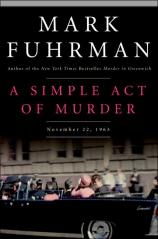A Simple Act of Murder: November 22, 1963
Review
A Simple Act of Murder: November 22, 1963
In Mark Fuhrman's new book, A SIMPLE ACT OF MURDER, the relatively slim volume (it comes in at a little over 240 pages, including photographs and diagrams) on the JFK assassination, he intentionally takes a different tact than the other conspiracy books out there (and there are over 450 on this case alone). Instead of starting with a suspect and working backwards, Fuhrman utilizes his detective training and begins his search at the crime scene. As he asserts, "that's not how murders are solved. Instead, a homicide detective starts at the crime scene and moves out from there, listening to the evidence and following where it leads him."
Fuhrman closely examines the physical evidence and addresses the so-called "single bullet" or "magic bullet" theory as he makes a case for Lee Harvey Oswald being the lone gunman. He breaks down the shot sequence and suggests that it has been misrepresented all along. He points out the mistakes made, from the autopsy right on through the preliminary investigation and the subsequent Warren Commission. With all the conflicting information out there, he feels that the trouble in previous investigations has always been not the "lack of information but rather the proliferation of it."
Unlike other volumes on this case, Fuhrman is not overly concerned with conspiracies, suspects or even motive. He relies more on the ballistics evidence and the crime scene itself. His breakdown of the shot sequence and the bullets themselves can be a little technical --- perhaps a bit too technical for novice readers --- and his ultimate findings might alienate hardcore conspiracy theorists. After all his research, he feels that too much has been made of the conspiracy aspect of the murder and that those conspiracies exist more to protect the living rather than the dead.
His earlier book, A MURDER IN GREENWICH: Who Killed Martha Moxley?, brought to light critical, new information in that case and led to the Connecticut Grand Jury to reform and reopen the case, ultimately resulting in Michael Skakel being tried and found guilty for the 1975 murder. Because he eschews the myriad of conspiracies that have surrounded JFK's assassination for years, it's doubtful that this addition will revolutionize the genre. It's a tad too technical for newbies and a little too dismissive for resolute conspiracy theorists.
Reviewed by Bronwyn Miller on May 1, 2006
A Simple Act of Murder: November 22, 1963
- Publication Date: May 1, 2006
- Hardcover: 240 pages
- Publisher: William Morrow
- ISBN-10: 0060721545
- ISBN-13: 9780060721541









